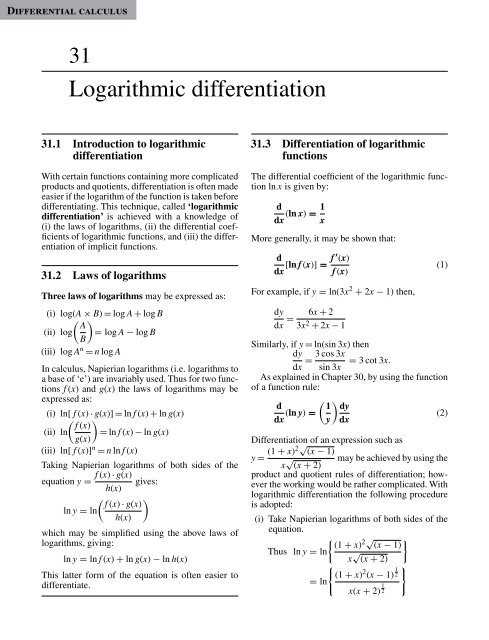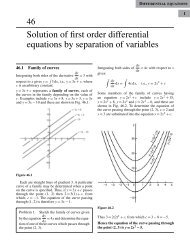differentiation
Create successful ePaper yourself
Turn your PDF publications into a flip-book with our unique Google optimized e-Paper software.
Differential calculus<br />
31<br />
Logarithmic <strong>differentiation</strong><br />
31.1 Introduction to logarithmic<br />
<strong>differentiation</strong><br />
With certain functions containing more complicated<br />
products and quotients, <strong>differentiation</strong> is often made<br />
easier if the logarithm of the function is taken before<br />
differentiating. This technique, called ‘logarithmic<br />
<strong>differentiation</strong>’ is achieved with a knowledge of<br />
(i) the laws of logarithms, (ii) the differential coefficients<br />
of logarithmic functions, and (iii) the <strong>differentiation</strong><br />
of implicit functions.<br />
31.2 Laws of logarithms<br />
Three laws of logarithms may be expressed as:<br />
(i) log(A × B) = log A + log B<br />
( A<br />
(ii) log = log A − log B<br />
B)<br />
(iii) log A n = n log A<br />
In calculus, Napierian logarithms (i.e. logarithms to<br />
a base of ‘e’) are invariably used. Thus for two functions<br />
f (x) and g(x) the laws of logarithms may be<br />
expressed as:<br />
(i) ln[ f (x) · g(x)] = ln f (x) + ln g(x)<br />
( ) f (x)<br />
(ii) ln = ln f (x) − ln g(x)<br />
g(x)<br />
(iii) ln[ f (x)] n = n ln f (x)<br />
Taking Napierian logarithms of both sides of the<br />
f (x) · g(x)<br />
equation y = gives:<br />
h(x)<br />
( ) f (x) · g(x)<br />
ln y = ln<br />
h(x)<br />
which may be simplified using the above laws of<br />
logarithms, giving:<br />
ln y = ln f (x) + ln g(x) − ln h(x)<br />
This latter form of the equation is often easier to<br />
differentiate.<br />
31.3 Differentiation of logarithmic<br />
functions<br />
The differential coefficient of the logarithmic function<br />
ln x is given by:<br />
d<br />
dx (ln x) = 1 x<br />
More generally, it may be shown that:<br />
d<br />
dx [ln f (x)] = f ′ (x)<br />
f (x)<br />
For example, if y = ln(3x 2 + 2x − 1) then,<br />
dy<br />
dx = 6x + 2<br />
3x 2 + 2x − 1<br />
(1)<br />
Similarly, if y = ln(sin 3x) then<br />
dy 3 cos 3x<br />
= = 3 cot 3x.<br />
dx sin 3x<br />
As explained in Chapter 30, by using the function<br />
of a function rule:<br />
( )<br />
d 1 dy<br />
dx (ln y) = (2)<br />
y dx<br />
Differentiation of an expression such as<br />
y = (1 + x)2√ (x − 1)<br />
x √ may be achieved by using the<br />
(x + 2)<br />
product and quotient rules of <strong>differentiation</strong>; however<br />
the working would be rather complicated. With<br />
logarithmic <strong>differentiation</strong> the following procedure<br />
is adopted:<br />
(i) Take Napierian logarithms of both sides of the<br />
equation.<br />
{ (1 + x)<br />
2 √ }<br />
(x − 1)<br />
Thus ln y = ln<br />
x √ (x + 2)<br />
{<br />
}<br />
(1 + x) 2 (x − 1) 2<br />
1<br />
= ln<br />
x(x + 2) 2<br />
1










